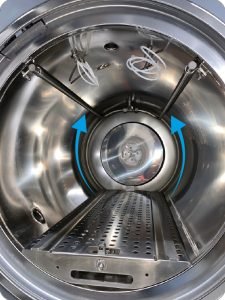Rapid sterilization and cooling for improved efficiency
Autoclaves are often used for the inactivation of fragile or deformable sterilization materials. Such items may include cans made of thin sheet metal, plastic bottles, plastic bags and large glass bottles. Plastic, in particular, is susceptible to deformation during heating due to its poor thermal conductivity. The hot water spray heating and the spray cooling program, combined with the usage of support pressure inside the Systec autoclaves, effectively minimizes the risk of damaging such sterilization materials while also accelerating the overall sterilization process. The active spray cooling also reduces the re-cooling time of the sterilization materials by more than 90% when compared to self-cooling. Batch times are correspondingly reduced since less time is required for the sterilization material to cool down.
How sterilization and re-cooling using the spray heating and cooling program work
With the spray heating and cooling program (as implemented in the Systec autoclaves of the VX/VE, DX/DE and HX series), the sterilization material in the autoclave is sprayed with heated deionized water (alkali concentration ≤ 0.02 mmol/l, conductivity at 20 °C, 0.1 – 15 μS/cm) from the two (for chamber diameters 400 to 740 mm) or three (chamber diameter of 1,000 mm) built-in sprinkling lances (using the Systec H-Series as an example). The water is continually circulated by a circulation pump. This ensures a continuous, gentle and uniform sprinkling of the vessel surfaces and the proper temperature distribution within the vessels. A support pressure is simultaneously generated using compressed air (quality ≤ class 4 according to DIN ISO 8573). This ensures that the pressure built up inside the sterilization materials is compensated, which prevents deformation and bursting. This support pressure corresponds to a pre-selected factor of 1, 2 or 3 times the pressure measured in the sterilization container. It is limited to 5 bar / 500 kPa absolute pressure. During the subsequent re-cooling by means of spray cooling, the deionized water used for sterilization is passed through a plate heat exchanger. After it is cooled down, this water is then sprayed through the sprinkling lances onto the sterilization materials. Here again, support pressure is used to prevent deformation and bursting.
Material-friendly heating and cooling uses deionized water for less waiting between autoclaving procedures
The combination of sterilization by hot water spray heating and active cooling by deionized water with simultaneous support pressure is the perfect method for sterilizing sterilization materials made of fragile or deformable material. It not only ensures perfect sterilization results, but also significantly accelerates cooling. This is a clear advantage over self-cooling, especially when working with large batches.
Do you have any questions on the program “Spray heating and spray cooling” or on the correct sterilization of sterilizable goods, then please contact us!


